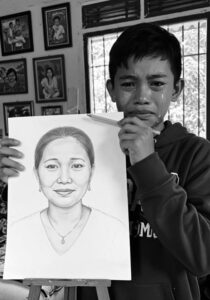In the world we live in, stories of love, loss, and resilience often come from the most unexpected places. One such story recently emerged that has touched the hearts of many—a young child who painted a portrait of her late mother, only to be met with silence and a lack of support from those around her.
The image of this child carefully painting her mother’s likeness is more than just an art project. It is a profound expression of love, grief, and remembrance. For this child, the painting is a way to keep her mother’s memory alive, a tangible connection to someone she lost far too soon. Yet, despite the emotional weight behind her act, the world around her seemed indifferent, with little encouragement or comfort offered.
Losing a parent at a young age is one of life’s most difficult challenges. It leaves a void that no one else can fill. For many children, creative outlets such as drawing, painting, or writing become essential coping mechanisms. They allow them to process emotions that are otherwise too complex to express with words.
This particular child, whose story has spread widely on social media, chose to immortalize her mother through art. The painting she created is striking, filled with vibrant colors and delicate brushstrokes that capture the warmth and kindness her mother once radiated. But what makes the story even more heartbreaking is the reaction—or lack thereof—from those who saw it.

Rather than receiving support or encouragement, the child was met with indifference or, worse, criticism. Some viewers dismissed the painting as merely a child’s scribble, failing to recognize the deep emotional significance behind it. Others ignored the child altogether, unwilling or unable to offer the empathy and kindness she so desperately needed.
This response highlights a troubling reality: society often overlooks the emotional needs of grieving children, especially when they do not express their pain in conventional ways. While adults may understand the complexities of grief, children’s ways of coping can be misunderstood or dismissed as trivial.
Support is crucial at this vulnerable time. Children who have lost loved ones need reassurance, comfort, and opportunities to express their feelings openly. Encouragement from family, friends, teachers, and the community can make a tremendous difference in their healing process.
The child’s painting is more than just art—it is a cry for connection and understanding. It reminds us that behind every creative act lies a story of human emotion, often deeply personal and profoundly moving.
In this young artist’s brushstrokes, we see love, loss, and hope intertwined. We see a child’s bravery in facing grief head-on and attempting to find solace through creation. It is a poignant reminder to all of us to look beyond the surface and offer compassion to those silently suffering around us.
This story also challenges us to rethink how we respond to children dealing with trauma. Instead of dismissing their expressions, we should listen closely, validate their feelings, and provide the support they deserve. After all, healing begins with feeling seen and heard.
In a world that can sometimes seem cold and indifferent, the innocence and courage of this child shine brightly. Her painting is a legacy of love that will endure, a symbol of resilience amid heartbreak.
It calls upon each of us—families, communities, and individuals—to be more attentive, to nurture the hearts of the young and vulnerable, and to stand as pillars of support when they need us most.
The image of this child painting her late mother is not just a picture on canvas—it is a testament to the enduring power of love and the human spirit. May it inspire us to be kinder, more compassionate, and more present for those who are quietly hurting.
News
Gerald Anderson, Umamin na sa Matagal na Itinatagong Damdamin, Pero Reaksyon ni Gigi De Lana, Lahat ay Nabigla
Sa isang hindi inaasahang pagkakataon, sa gitna ng isang kaswal na panayam, bigla na lamang umamin si Gerald Anderson…
Hindi mo na siya makikilala! Mula batang bituin hanggang sa malaking pagbabago, nagulat ang mga tagahanga ngayon
Sa industriya ng showbiz, walang mas matindi pa sa pagbabago — lalo na sa mga artista na lumalaki sa…
Hindi inaasahang paglisan ni Sotto mula sa DU30 bloc, nagdulot ng matinding intriga sa loob ng gobyerno ngayon
Sa mundo ng politika, laging may mga hindi inaasahang pangyayari na nagpapabago sa takbo ng mga pangyayari. Isa na…
Sorpresang Relasyon! Kitty Duterte, Kasintahan ang Apo ni Chavit Singson na Nagpasiklab ng Usapin
Sa mundo ng politika at showbiz sa Pilipinas, laging may mga kwentong nakakagulat na umaalingawngaw sa publiko. Isa sa mga…
Nikko Natividad, Matapang na Tinalo ang Basher na Sumira sa Bagong Resort—Nagdulot ng Labis na Gulat sa Publiko!
Muling pinatunayan ni Nikko Natividad ang kanyang katapangan nang harapin niya ang mga basher na tumuligsa sa kanilang bagong…
Nabunyag ang Lihim: Si Julia Barretto, Tatlong Buang Buntis sa Bagong Nobyo — Galit ni Gerald Anderson, Social Media Nag-Alab!
Nabunyag ang isang nakakagulantang na balitang nagpaalab sa showbiz at social media: si Julia Barretto ay tatlong buwan nang…
End of content
No more pages to load












